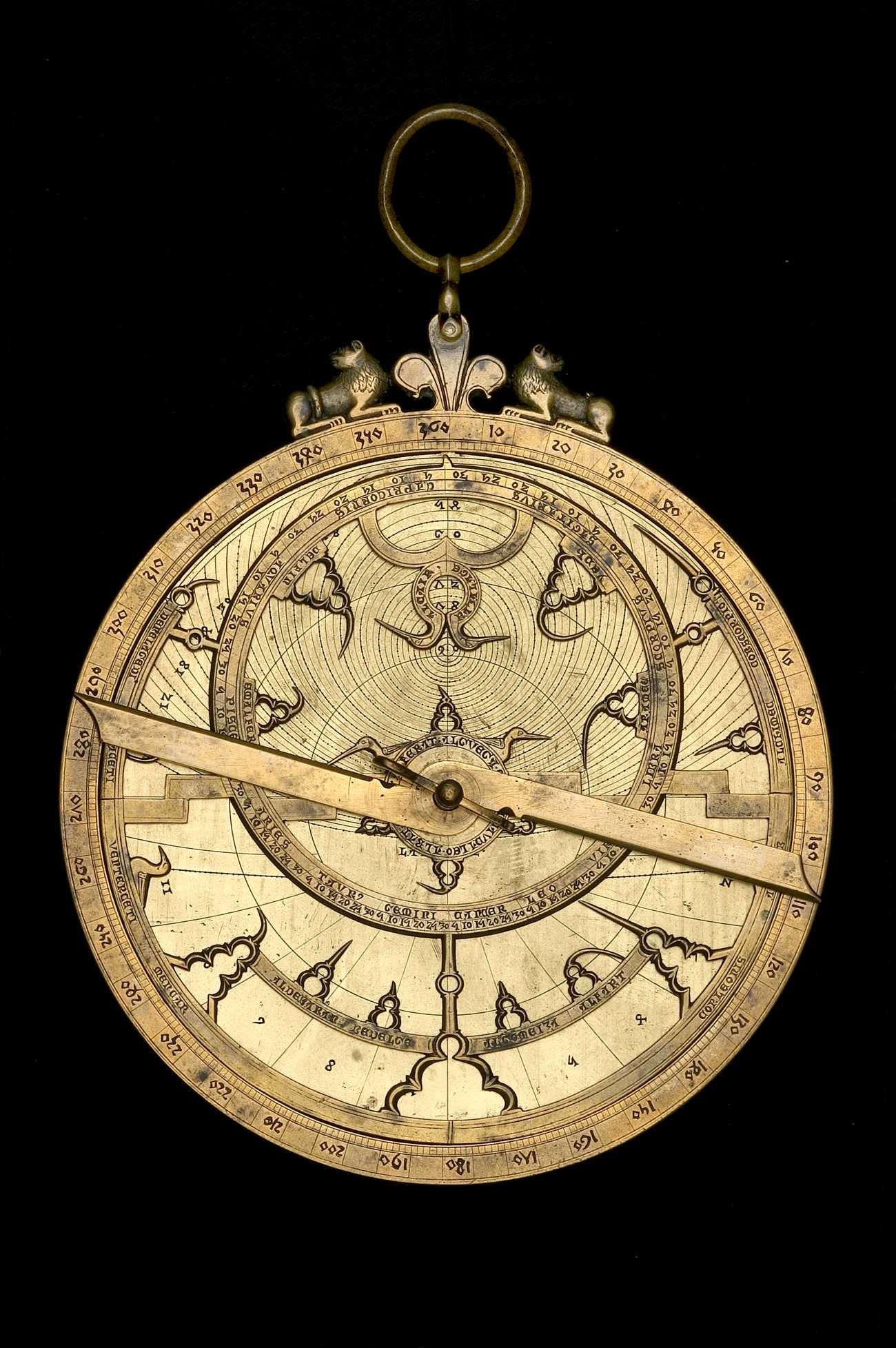 |
| The front of the al-Khujandi astrolabe made in 984/985 AD Museum of Islamic Art, Doha, Qatar |
The Museum for Islamic Art in Doha (Qatar) holds a significant collection of astrolabes, most of which are acquired recently from a private collection. Between all of the astrolabes, especially one instrument stands out in beauty and importance and is without doubt one of the most important astrolabes of the early Islamic period.
Made personally by the famous Persian astronomer/mathematician al-Khujandi (flourished in the 10th century), this astrolabe made in 374 AH (984/985 AD) is not only one of the oldest surviving dated astrolabes, but also one of the most beautiful, combining exact astronomical and mathematical knowledge with accurate craftsmanship and artistic decoration. For this reason, this instrument is not only an outstanding example of a medieval scientific instrument, but also a true piece of art.
The al-Khujandi astrolabe, which was previously owned by a Kuwaiti, who fled the Iraqi invasion of the country in the 90's, was later sold and finally ended up in Doha at an early stage.
Suprisingly, with the later acquisition of a large group of astrolabes, the collection now holds an astrolabe, coming from the collection of Leonard Linton (known as the Linton collection) which has features clearly derived from the much older al-Khujandi astrolabe, which was already in the collection. A fact, which was already pointed to by David A. King, world expert on medieval astronomical instruments.
This astrolabe, made in India in 1017 AH (1608/9), is signed in Arabic by a certain "Wafâ' b. munajjim". There is another inscription in Nagari script (Sanskrit) which, according to the Linton collection catalog, stems from the 19th century.
 |
| The "Linton" astrolabe made in India in 1608/1609, showing features clearly derived from the al-Khujandi astrolabe. Museum of Islamic Art, Doha, Qatar |
A quick comparison between the two astrolabes shows that the spider (rete in Lat. al-ankabut in Arabic), which contains all the starpointers, has several features which are clearly derived from the al-Khujandi astrolabe made more than six centuries before. First, quadrefoil figure in the upper center line seems identical to the al-Khujandi. Also the reversed "heart"shape with the two pointer on both sides are similar. Furthermore, the inward looking bird figures on the upper left and right and inward looking bird figures in the lower left and right are also clearly derived from the al-Khojandi astrolabe. One of the most remarkable features on the derivative astrolabe is that the very characteristic "smiley" figure on the lower part now has lost his head and only his legs survive.
David A. King also points to another, much older, astrolabe, now in the collection of the Adler Planetarium (Inventory number #2557) , which also seems to be a derived from the al-Khujandi astrolabe. This astrolabe was made by Badr ibn Abdallah in the year 525 AH (1130/1131 AD).
 |
| Astrolabe made by Badr ibn Abdallah in 525 AH ( 1130/1131AD). Inventory No. 2557 By courtesy of the Adler Planetarium, Chicago. |
Finally, there is one western astrolabe in the collection of the Oxford Museum for the History of Science,with the inventory number #45307, again pointed to by David A.King, also having some features which somewhat resembles those of the al-Khujandi astrolabe, making one wonder if there is somehow a case of "transmission".
 |
| Western astrolabe made in Spain ca. 1300, Inventory #45307 By Courtesy of the Museum for The History of Science, Oxford |
This all shows that, although it is not clear how the transmission of these stylistic figures took place, the stylistic and artistic features of the al-Khujandi astrolabe kept being an inspiration for later astrolabe makers and survived for more than six centuries.
Sources:
David A. King, In Synchrony with the Heavens: Instruments of Mass Calculation, Brill, Leiden, 2005, p 973-979.
Linton Collection Catalogue, Point Lookout, New York, p 121-123, No: 179
Gibbs, Sharon with Saliba, George, Planispheric Astrolabes from the National Museum of American History, Smithsonian Institution Press, City of Washington (1984).
This work can be downloaded for free from the following link -->
http://www.sil.si.edu/SmithsonianContributions/HistoryTechnology/pdf_hi/SSHT-0045.pdf (76 Mb)